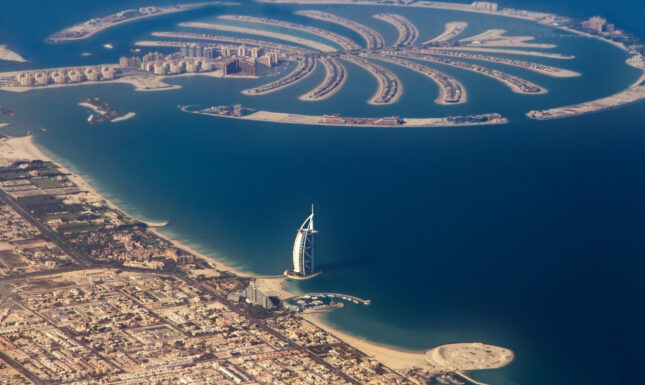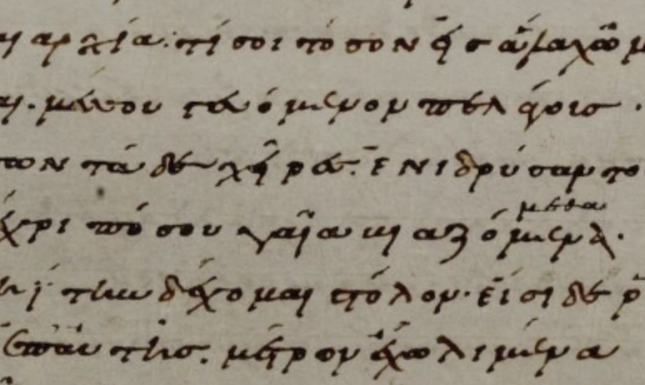How to be troubled by a bridge over water
When humans alter the natural landscape, this often elicits strong human responses. In this blog, Kees Geluk discusses an ancient Greek poem on a harbour mole and compares it to modern environmental attitudes.
On a warm summer evening last year, I looked up into the sky when something mysterious caught my attention. It looked like a train of little light bulbs, with the same distance between each bulb – the sort of string lights you find in a Christmas tree – and it slowly moved across the horizon. Someone passed by, noticed me staring up, and said: “Those are the new satellites of Elon Musk. Really appalling, don’t you think?”
Browsing the internet, I later found out that what I had seen was part of Musk’s Starlink project: a mega-constellation of thousands of satellites that aims at bringing high-speed internet coverage to the whole planet. In many online comments, under articles and on fora, the idea of ‘Wi-Fi for everybody’ was warmly welcomed. But parallel to this positive response was a prominent negative strand: people considered these trails of satellites ‘visual pollution’ and ‘degradation of the landscape’. Besides serious concerns about the threat of collision risks and radio interference to astronomical instruments, online discussions also took a different direction. Considering that SpaceX is just one of many commercial companies that continue to launch new satellites into low Earth orbit, do we want our sky to be completely filled with human-made objects in a couple of generations? Isn’t the experience of a serene night sky (and the deep contemplation that often comes with it) something fundamental to a human being?
Landscape alterations often elicit strong human responses. Be it tunnels or roads, deforestations, ambitious city planning or solar panels: when we are confronted with human intervention in or manipulation of the natural landscape (indeed itself already charged terms), we tend to form an opinion about it. This can be positive or negative and everything in between: for some, Dubai’s Palm Islands, the artificial palm-shaped archipelago just off the coast, has become the ultimate symbol of lavish lifestyle and technical innovation (‘man’s dominion over nature’)– tourist offices even claim it to be the 8th World Wonder. For others, it represents the pinnacle of human hubris, pointing at the disastrous environmental consequences for biodiversity and coastal ecology, often resorting in their arguments to terminologies of sustainability and natural balance.


This kind of environmental engagement is of course not new, as we find comments on landscape alteration already in ancient Greek and Latin texts. In my PhD project, launched last December and part of Anchoring Innovation, I (in part) investigate these ancient attitudes to natural interventions. The project specifically focuses on a time period that experienced a radical shift in power: the late Hellenistic and early imperial period (the texts I investigate were written from roughly 60 BCE to 50 CE). During the first century BCE, the Roman empire increasingly gained power, and when Octavian (the later emperor Augustus) in 31 BCE conquered Mark Antony and Cleopatra, the rulers of the last remaining Hellenistic kingdom, he decisively united the eastern and western parts of the Mediterranean into one empire. Greek-speaking intellectuals from the east – poets, rhetoricians, philosophers – had to accommodate themselves to this new empire, with a new, absolute ruler. Many of them migrated to Rome, the new cultural centre, to start teaching and writing there.
In a specific corpus of poetic texts written by these Greek-speaking intellectuals (the Garland of Philip, an anthology of almost 600 short Greek poems, compiled by the poet Philip of Thessalonica), they frequently reflect, both implicitly and explicitly, on the relationship between the rise of Rome and the natural world in which that took place. One example is the following poem, written by the poet Antiphilus, of whom we, unfortunately, know nothing but his 50 surviving poems. The poem is about a man-made harbour mole – a fixed dam, pier – in the city of Puteoli, in the bay of Naples (modern Pozzuoli), which was formerly known as the Greek colony of Dicaearchia. It was an important trade harbour of Rome until emperor Claudius started constructing an artificial harbour at Ostia in 42 CE. The poem takes on the form of a short conversation: the first four verses are presumably spoken by the sea, or a sea creature; the last couplet by Puteoli itself.
-- Tell me, Dicaearchia, why have you cast so great a mole into
the waters, touching mid-ocean? Cyclopean were the hands
that planted these walls in the sea. How far, Earth, must we
suffer your violence?
-- I am harbour to the world’s fleet of ships. Look at Rome
near-by, and judge if I have not a haven the measure of hers.
Antiphilus III in Gow and Page's 1968 edition, the translation is theirs.
What we read is a question (or actually, two) and an answer. First, the city of Dicaearchia (Puteoli) is asked why the harbour mole has been constructed. Second, Earth is asked to what extent ‘we’, presumably the sea, is overpowered or constrained. It strikes me that in these first four verses, the poet conveys (through the sea’s perspective) an implicit idea of some sort of disbalance: the landscape has been manipulated and the sea appears to experience this as a transgression. The city and Earth (as a personification of mankind?) seem to have done something out of place. Such an attitude is not so different from what some of us might experience today, when looking at, say, a trail of satellites or an artificial island.


The last couplet of the poem, however, provides what seems to be an explanation or justification for the disbalance. The mole has been planted because Puteoli is home to the world’s fleet, and this world harbour is measured against Rome’s harbour. So, in other words, the fact that Puteoli has a harbour that matches Rome’s justifies this natural transgression. The idea may be that Rome brings order and civilization by dominating the landscape - just as Dubai with its palms.
But is the balance fully restored? For a (contemporary) reader with some mythological baggage, the idea that the mole was planted by the hands of a Cyclops is curious: it could indeed just be a technical term to denote the impressiveness of the construction, as it is for instance used to describe the city walls of Mycenae, but a Cyclops also traditionally stands for barbarism and primitiveness. To compare Rome’s intervention in nature with the actions of Cyclopes opens up the possibility of more subversive reading: Rome’s intervention in nature and perhaps its imperialism more in general, might not be so ‘civilized’, and might be transgressing certain natural boundaries. Here, the natural world could also work as a vehicle to subtly criticize Rome’s expansionism.
The interpretation can go both ways, and we will probably never be sure about Antiphilus’ intentions. But what this poem does reveal, I think, is that Antiphilus employs the relationship between Rome and the natural world, as a means to make sense of the societal developments in his time. Other poets in the Garland of Philip similarly resort to natural phenomena, like animals, trees and plants, in which they anchor the rise of the Roman empire. My project will try to answer the question of how this relationship between Rome and the natural world is presented and constructed by them, and how it helps them to make sense of a new world order.
Back to now. Since the first century CE, a lot has changed, not in the least our scientific knowledge of the actual environmental impact of landscape alteration. By contrast, ancient environmental attitudes were often also rooted in a religious framework. Despite these (and other) differences, however, a peek at ancient responses could go some way in helping us better understand where modern attitudes to human intervention in nature come from: Antiphilus’ bridge over troubled water as a mirror to our reaction to Musk’s satellites and Dubai’s islands.
Further reading and references
https://www.theguardian.com/science/2020/sep/12/stars-astronomy-spacex-satellite-elon-musk
https://catalystmcgill.com/dubais-artificial-islands-cutting-edge-innovation-or-ecological-disaster/
Gow, A.S.F., Page, D.L. 1968. The Greek Anthology: The Garland of Philip and Some Contemporary Epigrams. Cambridge.
de Jonge, C.C. 2022. ‘Greek Migrant Literature in the Early Roman Empire’, Mnemosyne 75.1, 10-36.
König, J. 2022. ‘Ecocritical Readings in Late Hellenistic Literature: Landscape Alteration and Hybris in Strabo and Diodorus’, in J. König, N. Wiater (eds.). Late Hellenistic Greek Literature in Dialogue. Cambridge, 120-148.
Schliephake, C. (ed.) 2017. Ecocriticism, Ecology, and the Cultures of Antiquity. Lanham.
Sluiter, I. 2017. ‘Anchoring Innovation: a Classical Research Agenda’, European Review 25(1): 20-38.



0 Comments